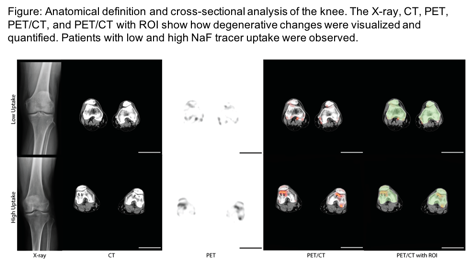Session Information
Session Type: ACR Poster Session A
Session Time: 9:00AM-11:00AM
Background/Purpose: Previous studies using 18F-sodium fluoride positron emission tomography (NaF-PET) have quantified the increase in bone formation associated with osteoarthritic (OA) abnormalities with the maximum standardized uptake value (SUVmax) in user-defined regions of interest (ROIs). A limitation of this method of quantification is that it assumes that the voxel with the highest SUV within the ROI represents the overall activity of the affected tissue. To address this limitation, we developed a novel method of global joint analysis to assess regions of expected bone turnover in articulating joints using NaF-PET in a group of patients at high risk for OA.
Methods: The study population consisted of 18 patients with Rheumatoid Arthritis who underwent static NaF-PET 90 minutes after the intravenous administration of NaF tracer. The global knee activity was defined as the area-weighted average of the mean NaF tracer uptake within the ROI. These global assessments at the knee were subsequently adjusted for overall bone formation at a non-articular location by determining the ratio of tracer uptake at the knee over the uptake at the femoral neck. For comparison, the SUVmax for each ROI was calculated methods. Standard radiographs of the knee were also obtained from the medical record in 9 patients and scored by a radiologist using the Kellgren-Lawrence (K/L) grading system.
Results: The average SUVmean score for the knees was 1.48 (SD = 0.68) with a range of 0.54 to 2.96. Patients with greater NaF uptake demonstrated greater deterioration of the medial and lateral intercondylar tubercles, as evidenced by the larger lesions in the corresponding NaF-PET/CT scans (Fig. 1). Greater NaF global joint activity was observed among individuals with higher K/L grading scores (_ = 0.69, p = 0.04). K/L grading was also associated with SUVmax values (_ = 0.93, p = 0.0003).
Conclusion: Both methods were strongly associated with K/L grading of knee OA. The potential advantage of the novel SUVmean method is that it may be more sensitive at detecting changes in intra-ROI OA progression since new spatially distinct lesions with a lower SUV that develop within an ROI would not be detected by the SUVmax methodology. Furthermore, the adjustment for fluoride uptake in non-articular sites is likely important in order to adjust for age-related declines in overall bone turnover. Further study is needed to determine the utility of this methodology in longitudinal studies.
To cite this abstract in AMA style:
Jonnakuti VS, Raynor WY, Taratuta EG, Alavi A, Baker J. A Novel Method to Assess Subchondral Bone Formation Using Naf-PET in the Evaluation of Knee Osteoarthritis [abstract]. Arthritis Rheumatol. 2017; 69 (suppl 10). https://acrabstracts.org/abstract/a-novel-method-to-assess-subchondral-bone-formation-using-naf-pet-in-the-evaluation-of-knee-osteoarthritis/. Accessed .« Back to 2017 ACR/ARHP Annual Meeting
ACR Meeting Abstracts - https://acrabstracts.org/abstract/a-novel-method-to-assess-subchondral-bone-formation-using-naf-pet-in-the-evaluation-of-knee-osteoarthritis/

